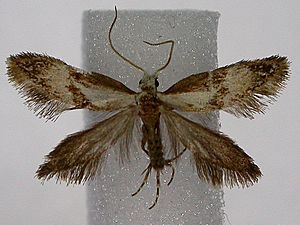Mnesarchaea facts for kids
Quick facts for kids Mnesarchaea |
|
|---|---|
 |
|
| Scientific classification |
|
| Kingdom: | Animalia |
| Phylum: | Arthropoda |
| Class: | Insecta |
| Order: | Lepidoptera |
| Suborder: | Glossata |
| Infraorder: | Exoporia |
| Superfamily: | Mnesarchaeoidea |
| Family: | Mnesarchaeidae |
| Genus: | Mnesarchaea Meyrick, 1885 |
| Species | |
|
See text |
|
| Diversity | |
| 7 described species | |
Mnesarchaeoidea is a special group of "primitive moths" found only in New Zealand. This group includes one family called Mnesarchaeidae and a single genus named Mnesarchaea. These moths are unique because they live nowhere else in the world.
Contents
What Are Mnesarchaeoidea?
Mnesarchaeoidea moths are very closely related to another group of moths called Hepialoidea. Within the Mnesarchaeidae family, there are two main types, or genera: Mnesarchaea and Mnesarchella. You can tell them apart by their colors. Mnesarchaea moths have white scales on their heads and bodies, while Mnesarchella moths have brown scales.
Right now, scientists know about 14 different species in this family. Four of these belong to the Mnesarchaea group, and ten belong to the Mnesarchella group.
Appearance and Features
These moths are quite small, with a wingspan of less than 12 millimeters (which is less than half an inch!). They usually have brown bodies.
Unlike some other moths, adult Mnesarchaeoidea moths have working mouthparts. This means they can feed. They also share some cool features with other moths in the Lepidoptera order, like a short, coiled tongue (called a proboscis) that they use to drink. They also have special glands that produce saliva.
Life and Habits
Most Mnesarchaeoidea moths fly during the day. You can often see them active from mid-spring to early autumn in New Zealand, which is from October to March. They are most active during daylight hours, but they might rest when the sun is at its brightest.
Male moths are the ones that fly around to travel. Female moths usually lay about 32 eggs in their lifetime. The young moths, called larvae (or caterpillars), live in silk tunnels they build under plants like liverworts and in the soil. They find their food while staying safe inside these tunnels until they grow up.
Known Species
Here are some of the species that belong to the Mnesarchaea genus:
- Mnesarchaea acuta Philpott, 1929
- Mnesarchaea fallax Philpott, 1927
- Mnesarchaea fusca Philpott, 1922
- Mnesarchaea fusilella Walker, 1864
- Mnesarchaea loxoscia Meyrick, 1888
- Mnesarchaea hamadelpha Meyrick, 1888
- = Mnesarchaea similis Philpott, 1924
- Mnesarchaea paracosma Meyrick, 1885
Discovery and History
When these moths were first found, early collectors like G.V. Hudson thought they belonged to other moth families. For example, the Mnesarchaea fusiella was first thought to be part of the Tinea family. But later, in the 1900s, scientists corrected these mistakes and placed them in their own unique family.

